Kingdome
Doom
by Randall
Woods
with photographs by
Heather Schenkel & Randall Woods
Changing
climates, political and otherwise,
bring down a sports arena.
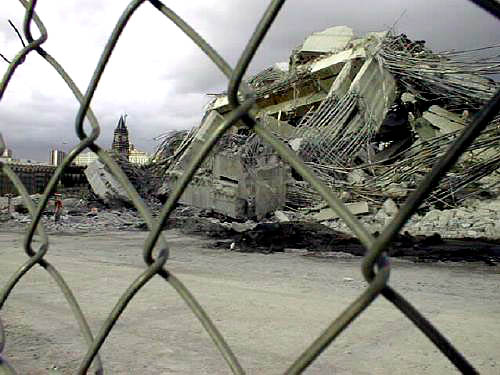
"How long will it be until our mood shifts again?"
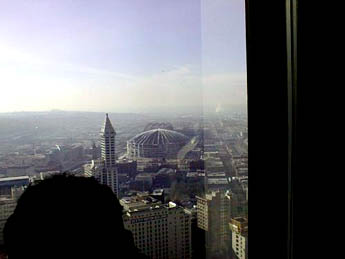 It
was a rare sunny spring morning in the city of Seattle. A light fog was
melting away in the warmth of the unexpected sunshine. Seagulls lazily
drew circles in the sky.
It
was a rare sunny spring morning in the city of Seattle. A light fog was
melting away in the warmth of the unexpected sunshine. Seagulls lazily
drew circles in the sky.
Suddenly, the stillness was shattered at precisely 8:32 a.m. by a series of rapid concussions, tearing through the air from the south. Windows rattled. The ground roiled. A huge cloud of dust leapt into the air, blocking out the sun. People in the streets dropped their half-caf, double-tall, no-foam mochaccino lattes and ran from the looming wall of dust, but it was of no use. The inexorable spread of the dust cloud plunged the city into an early twilight. When the dust finally settled -- a quarter-inch thick in some places -- all that was left was rubble. What a disaster. (Oh, the humanity!)
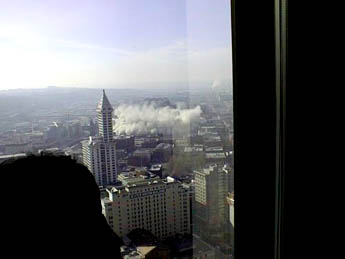 This
time, however, it was not Mt. St. Helens yawning back to life on the far
horizon. But exactly 20 years to the day -- March 27 -- after the infamous
volcano first began its stirrings that ended in the May 18, 1980, cataclysm,
another big, bloated Northwest icon, the Seattle Kingdome, blew itself
up -- well, actually, we Seattlites blew it up, all in the name of aesthetic
purity, ridiculously inflated Internet stocks, grass-stained uniforms
and that ravenous beast we call "progress." What took four years
to build took just 18 seconds to bring down (after three months of ripping
out the seats, playing fields, offices and other tobacco-juice-stained
equipment).
This
time, however, it was not Mt. St. Helens yawning back to life on the far
horizon. But exactly 20 years to the day -- March 27 -- after the infamous
volcano first began its stirrings that ended in the May 18, 1980, cataclysm,
another big, bloated Northwest icon, the Seattle Kingdome, blew itself
up -- well, actually, we Seattlites blew it up, all in the name of aesthetic
purity, ridiculously inflated Internet stocks, grass-stained uniforms
and that ravenous beast we call "progress." What took four years
to build took just 18 seconds to bring down (after three months of ripping
out the seats, playing fields, offices and other tobacco-juice-stained
equipment).
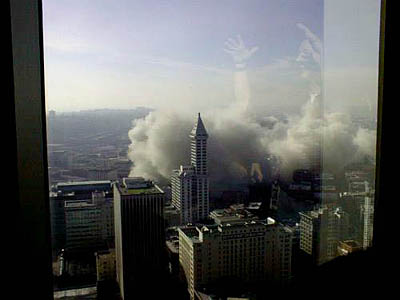
While many in Seattle cheered the implosion of the Kingdome -- at various times called the World’s Largest Concrete Dome, the Loudest Place in the National Football League, and Ugliest Goddamn Pile of Rocks You Ever Saw -- there were an equal number of residents who shed a nostalgic tear with its passing. Many of those who groused for 24 years about the Dome’s cement parking-garage appearance, winced at the skidding effect the bluish-green artificial turf had on opponents’ ground balls slapped up the middle, and generally suffered loudly through the endless series of sports-related disasters perpetrated by the notoriously underachieving Seahawks and Mariners began to go soft on their old behemoth friend. From the day of the 1997 vote to kill the stadium up until the last few weeks of 1999, some fans mounted a day-late, dollar-short "Save the Dome" campaign, even as the demolition crews began drilling the 6,000 dynamite holes and tearing out the too-narrow seats.
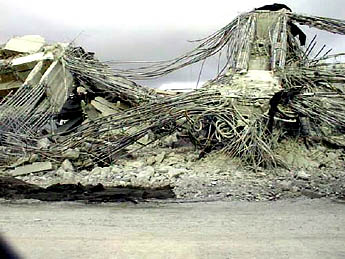 Emotionally,
it’s a long way from 1976, the year the Kingdome opened as an unmitigated
engineering wonder. In those days of urban renewal, modernism and frugality,
the Dome was to be the symbol of Seattle’s final acceptance into
the elite club of "great U.S. cities." Cursed with a lifelong
inferiority complex, due to it’s isolation behind the stunning Cascade
Range, the city of Seattle was like a nouveau riche family buying its
way into high society; for Seattlites, membership in the American League
and NFL social clubs meant that Seattle had, at last, "arrived."
Emotionally,
it’s a long way from 1976, the year the Kingdome opened as an unmitigated
engineering wonder. In those days of urban renewal, modernism and frugality,
the Dome was to be the symbol of Seattle’s final acceptance into
the elite club of "great U.S. cities." Cursed with a lifelong
inferiority complex, due to it’s isolation behind the stunning Cascade
Range, the city of Seattle was like a nouveau riche family buying its
way into high society; for Seattlites, membership in the American League
and NFL social clubs meant that Seattle had, at last, "arrived."
And the staggering lists of Kingdome stats backed up that image. Here are just a few: 250 feet high ... 67 million cubic feet in volume ... built from 52,800 cubic yards of concrete, weighing 130,000 tons ... able to seat 66,000 people ... 120,000 square feet of artificial turf ... a concrete roof covering 7.85 acres ... 660 feet in diameter -- so wide that if that other symbol of Northwest progress, the Space Needle, were laid down sideways inside the Dome, it could be spun like a top without scraping the outer wall. All this for a paltry $67 million. Truly a monument for the ages.
Fast-forward two decades...
The pride felt in the late ‘70s had quickly faded to embarrassment by the end of the millennium. A whole generation grew up watching the two pathetic Seattle teams struggle to reach .500 each year inside their concrete mausoleum. While both teams have improved to at least contender status in recent years, the stigma of the ugly utilitarian dome, with the orange-juicer-like roof, remained a symbol of all the bad choices the teams had made over the years. Sports purists complained that football and baseball need separate parks suited to their respective game’s dimensions, and that the big elephant on the south side of town should never have been built in the first place.
As this feeling of inadequacy grew in the Emerald City, so did the national sports world’s contradictory obsession with nostalgic, "old-school" park design and outrageously expensive luxury suites. Seeing the mountains of cash the sparkling new cookie-cutter bandboxes made for ball club owners in Baltimore, Cleveland, Denver and Arlington, Texas, the Mariners and Seahawks simply couldn’t resist blackmailing the long-suffering Seattle fans. As both clubs went up for sale, the prospective owners threatened to move the teams to Los Angeles -- a fate worse than death for Seattle natives -- if they did not each get publicly funded, multimillion-dollar, single-use stadiums chock full of luxury suites.
Two referendum votes and a few "emergency" city council meetings later, the deals were done. The Mariners, who play during the driest, sunniest months in Seattle, would get a $517 million stadium ($417 million of which is being paid for by the citizens) with an expensive retractable-roof that may be used, oh, five or six times a season. Not to be outdone, the Seahawks, who play in some of the wettest, coldest, dreariest months the Pacific Northwest has to offer, will soon be allowed to play next door in another $400+ million stadium (only 1/4 of which will be paid by owner Paul Allen, despite his 11-figure net worth) with no roof over the playing field, so the players can feel the true glory of Seattle’s winter weather.
The yellowish-gray dust from the March implosion has long ago been washed away. The concrete towers of the new football stadium already are beginning to rise from the organized piles of Kingdome rubble. With the thrill of the implosion spectacle behind us, we are left with the hard, cold facts -- a perfectly functional, not-yet-paid-for, two-sport stadium, guilty of only being "aesthetically challenged," was destroyed to build two smaller, more expensive, less versatile structures that are more vulnerable to our lousy weather.
How long will it be until our mood shifts again? The Dome was expertly engineered to last for the ages; it lasted less than a quarter century. When will the cry arise for more stadiums to be built on top of the new ones? Just a few months after the new Mariners stadium was opened to much fanfare, the pouting Ken Griffey Jr., one of the city’s only bona fide national superstars, picked up all his marbles and stomped back home to Cincinnati. How long will that sliding roof attract fans if Griffey is no longer hitting moon shots off of it?
How many weeks into the 2002 Seahawks season (the first one in the new football stadium) will the fans last before they start thinking:
"Gee, this 40-degree, 40-mph wind and incessant drizzle really makes me feel uncomfortable in the stands. If only this place had a roof or something. And maybe it could be big enough for a baseball field, too, which could be interchanged with football. It could be dry in winter and air-conditioned in the summer. And in between football and baseball season, it could be used to house huge conventions, which would draw more visitors to Seattle and fill the city coffers. Yeah! It’s so crazy, it just might work! *Sigh!* If only such a structure could be built... "
Give it another 20 years and we’ll see.
The Dome is Dead! Long Live the Dome!
please email ducts with your comments.